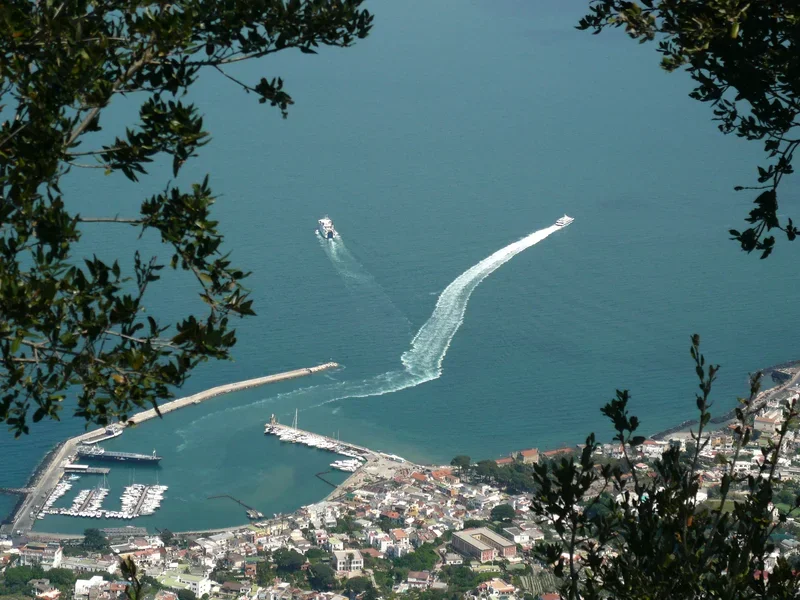Book your experience
Pompeii
Pompeii, a name that immediately evokes images of history, tragedy and beauty preserved over time. Located at the foot of Mount Vesuvius, this ancient Roman city is an archaeological treasure that offers a unique glimpse into the daily life of an entire civilization, frozen in an instant in 79 AD. due to the volcano eruption. Today, Pompeii is one of the most visited archaeological sites in the world, attracting millions of tourists every year eager to explore its ruins and discover the secrets of a distant past. In this article, we will dive into the fascinating history of Pompeii, examining the ten highlights that make it so extraordinary. We will begin with an analysis of its history, from its origins to the crucial moments that marked its existence. The archaeological ruins of Pompeii are a journey through time, revealing not only the grandeur of Roman architecture, but also everyday details that make the lives of its inhabitants palpable. We will discover the Forum, the beating heart of public life, and the House of the Faun, which represents the pinnacle of domestic luxury. The Teatro Grande, with its perfect acoustics, will remind us of the importance of culture and entertainment in ancient times.We will not fail to admire the frescoes and mosaics that adorn the homes, works of art that tell stories and myths. The Villa of the Mysteries, with its enigmatic frescoes, will lead us to reflect on the cults and religious practices of the time. Furthermore, we will explore the advanced engineering of the water supply system, a fundamental aspect of city life. Finally, we will guide you through the opportunities for events and guided tours, providing you with useful information on how to reach this extraordinary place. Pompeii is not just a site to visit; it is an experience that enriches our understanding of human history and the resilience of a city that, despite everything, continues to tell its story.
History of Pompeii
Pompeii is an ancient Roman city located near Naples, famous for its tragic end in 79 AD. due to the eruption of the volcano Vesuvius. The city, which was flourishing commercial and cultural development, was completely buried by a rain of ash and lapilli, which preserved it over time.
The Origins
The origins of Pompeii date back to the 7th century BC, when the city was founded by the Greeks. Subsequently, in the 5th century BC, it came under the control of the Etruscans and then the Romans. Thanks to its strategic position, Pompeii became an important center of commercial and cultural exchange.
The Eruption of Vesuvius
On August 24, 79 AD, Vesuvius erupted catastrophically, releasing enormous quantities of ash, gas and rocks. The eruption buried Pompeii under approximately 4-6 metres of volcanic material, blocking life in the city and preserving its structures and objects for centuries.
The Rediscovery
Pompeii remained forgotten until 1748, when archaeological excavations began to reveal the extraordinary ruins of the city. These excavations continued over the centuries, bringing to light a unique testimony to the daily life of antiquity and providing an important window into Roman culture.
UNESCO World Heritage Site
In 1997, Pompeii was declared a World Heritage Site by UNESCO, recognizing its cultural and historical value. Today, it is one of Italy’s most important tourist destinations, attracting millions of visitors every year.
The archaeological ruins of Pompeii
The archaeological ruins of Pompeii represent one of the most important and fascinating sites of antiquity, offering a unique glimpse into the daily life of the ancient Romans. The city was buried under a thick layer of ash and pumice following the eruption of Vesuvius in 79 AD, thus preserving buildings, streets, objects and frescoes in an excellent state of conservation.
A journey through time
Walking through the paved streets of Pompeii, visitors can admire the original architecture of the homes, shops and public places, all perfectly preserved. The ruins offer important evidence of the daily life, habits and social practices of the inhabitants of the time.
Architectural features
The architectural structures of Pompeii range from simple homes to grandiose villas, characterized by frescoes, mosaics and elaborate decorations. The city is an exceptional example of Roman urban planning, with straight streets, public squares and an advanced drainage system.
Conservation and excavations
Since its discovery in the 18th century, Pompeii has been the subject of numerous archaeological excavations. Studies and conservation interventions have allowed these ancient ruins to be preserved, making Pompeii one of the most visited archaeological sites in the world. Excavations continue to reveal new treasures and information that enrich our understanding of life in ancient Rome.
The Forum of Pompeii
The Forum of Pompeii represents the heart of the public and social life of the ancient city. This vast square was the nerve center where the political, religious and commercial activities of the Pompeian community took place.
History and Importance
The Forum was already in use in the 6th century BC and over the centuries it has undergone various transformations. Originally, it was an open area used as a market, but over time, important public buildings, such as temples, basilicas and columns, were built around it.
Architecture and Structures
The Forum is surrounded by numerous significant buildings:
- Temple of Jupiter: dedicated to the main god of the Roman pantheon, it is one of the most impressive buildings in the Forum.
- Basilica: used for legal and commercial activities, it has a structure with three naves.
- Temple of Apollo: an important place of worship dedicated to the god Apollo, characterized by Doric style columns.
Activities and Daily Life
The Forum was not only a meeting place, but also a point of reference for the daily life of the Pompeians. Here fairs, public discussions and religious events took place. The presence of statues and commemorative monuments celebrated the city’s illustrious citizens and important events.
Visit to the Forum of Pompeii
Today, the Forum of Pompeii is one of the main attractions for visitors. Walking among the ruins, you can perceive the vibrant atmosphere of a past time, imagining the daily life of the ancient Pompeians. tourist guides often offer insights into the history and importance of this place, making the visit even more fascinating.
The House of the Faun
The House of the Faun is one of the most important and fascinating buildings in Pompeii, located in the heart of the ancient city. This aristocratic residence, built in the 2nd century BC, owes its name to a statue of a faun located in the internal courtyard, symbolizing the connection with mythology and the divinities of nature.
Architecture and Design
The House of the Faun stands out for its considerable size, extending over an area of approximately 3,000 square metres. The building is characterized by a typical courtyard layout, with rooms arranged around a large central atrium. Roman architects were able to integrate Greek architectural elements, evident in the colonnades and decorations, creating a space that reflects the luxury and prestige of aristocratic life.
Frescoes and Mosaics
Inside the house, visitors can admire frescoes and mosaics of extraordinary beauty. One of the most famous mosaics is the one representing the Battle of Alexander against Darius, a work of art that illustrates the mastery of Pompeian artists. The frescoes, characterized by bright colors and intricate details, tell mythological stories and scenes of everyday life.
Function and Meaning
The House of the Faun was not only a residence, but also a center of social and cultural aggregation. Archaeologists believe it was used to host banquets and events, reflecting the wealth and power of its owners. The presence of several rooms, including a triclinium (dining room) and a library, suggests an idea of intellectual and convivial life.
Visit and Rediscovery
The House of the Faun was discovered during the excavations of 1748 and has been the subject of numerous restorations over the years. Today, it is one of the essential stops for those visiting Pompeii, offering a fascinating look at the daily life and culture of ancient Rome.
The Great Theater of Pompeii
The Teatro Grande of Pompeii is one of the most significant and well-preserved monuments of the ancient Roman city, representing an extraordinary example of the theatrical architecture of the period. Built in the 3rd century BC, the theater could accommodate around 5,000 spectators and is located at the foot of the Jupiter Hill, in a strategic position that offers a panoramic view of the city.
Architectural Features
The Teatro Grande is characterized by impressive architecture, with a decorated stage and an auditorium divided into sectors to facilitate public access. The structure is made of tuff and travertine, typical materials of Roman architecture. The auditorium is divided into three tiers of steps, with particular attention to acoustics, which allows the performances to be clearly heard even from the last seats.
Function and Activity
The theater was used for a variety of events, including comedies, tragedies, dance performances and concerts. It was a place of entertainment and culture, where the community gathered to watch performances that reflected the traditions and beliefs of the time. The Great Theater of Pompeii was a vital center for the social and cultural life of the city.
Archaeological Discoveries
During the excavations, numerous finds were found, including sculptures and inscriptions, which provide valuable information on the life and traditions of the ancient Pompeians. Furthermore, the theater has undergone various restorations over the centuries, helping to preserve its magnificence and historical importance.
Visits to the Teatro Grande
Today, the Teatro Grande is part of the archaeological site of Pompeii and can be visited by tourists. Guided tours offer a unique opportunity to explore the history and architecture of this extraordinary monument, immersing yourself in the atmosphere of ancient Rome.
The frescoes and mosaics of Pompeii
Pompeii is famous not only for its archaeological ruins, but also for the extraordinary quality and variety of the frescoes and mosaics that decorate the buildings of the ancient city. These works of art offer an important testimony to the daily life, beliefs and aesthetic tastes of its inhabitants.
Frescoes
The frescoes of Pompeii were created with advanced techniques that allowed the creation of vivid and detailed colors. Many of these frescoes decorate the walls of villas, houses and temples, and portray mythological scenes, landscapes, and moments of daily life. Among the most famous works are:
- The Villa of the Mysteries: a cycle of frescoes representing a mysterious initiatory rite, characterized by lively scenes and intense colours.
- The House of the Faun: here you can admire frescoes depicting dancers and festive scenes, highlighting the social life of the time.
Mosaics
The mosaics of Pompeii are equally impressive and often used to decorate the floors of homes. Made with small stone and glass tiles, some mosaics are true artistic masterpieces. Among the best known we find:
- The Alexander Mosaic: located in the House of the Faun, it represents a battle between Alexander the Great and King Darius, showing great artistic skill and attention to detail.
- The floor mosaic of the Villa of the Mysteries: an example of how mosaics can tell complex stories through the arrangement of the tiles.
Historical and cultural importance
The frescoes and mosaics of Pompeii not only represent the art of the time, but also a window into the culture and traditions of ancient Pompeii. Their discovery has contributed significantly to our understanding of the daily life, religious beliefs and artistic influences of the Roman era. Thanks to excavation and restoration work, these works continue to be studied and admired, attracting visitors from all over the world.
The Villa of the Mysteries
The Villa of the Mysteries is one of the most fascinating and important archaeological discoveries of Pompeii, located on the outskirts of the ancient city. This villa, which dates back to the 2nd century BC, is famous for its extraordinary frescoes and well-preserved architecture.
Architecture and Structure
The villa extends over an area of approximately 4000 square metres and has an architectural layout typical of Roman domus, with a central peristyle and several rooms used for various functions. The environments are characterized by an excellent organization of spaces, which reflects the standard of living of its inhabitants.
Frescoes and Meaning
One of the most surprising aspects of the Villa dei Misteri are the famous frescoes that adorn the walls of one of the main rooms, known as the “Hall of the Mysteries”. These frescoes represent an initiation rite, which is presumed to be linked to the cult of Dionysus, the god of wine and fertility. The figures depicted show dancers, musicians and a series of enigmatic scenes that continue to raise questions among scholars and visitors.
Cultural Importance
The Villa of the Mysteries is considered a fundamental example of Roman culture and daily life in Pompeii. Its frescoes offer an important testimony to the religious practices and rites of the time, making it a place of great interest for archaeologists, art historians and tourists.
Visits and Access
The Villa of the Mysteries is open to the public and can be visited together with the other archaeological sites of Pompeii. It is recommended to take part in guided tours to deepen your understanding of the works and the historical context in which they were created. Access is facilitated by well-marked routes and the site is equipped with information panels in different languages.
The Pompeii water supply system
The water supply system of Pompeii is one of the most fascinating and advanced aspects of daily life in the ancient city. Thanks to a complex and well-designed network, the inhabitants of Pompeii had access to sources of drinking water, which were essential for their survival and for the functioning of daily activities.
Sources of supply
Pompeii was mainly fed by two main sources:
- Madonna Water Spring: Located north of the city, this spring provided high quality water.
- Serino Source: coming from an aqueduct, this source was fundamental for the city’s supply.
Aqueduct
The aqueduct system was highly technological for the time, with terracotta pipes and masonry channels. The water was transported from the springs to the city through an aqueduct that exploited gravity. This system guaranteed a continuous and regular supply of water.
Water distribution
Once it entered the city, the water was distributed through a network of pipes that reached various homes, public fountains and other buildings. Public fountains were positioned in various points, allowing the inhabitants to easily draw water.
Use of water
Water from the water supply system was used for several purposes:
- Domestic use: for cooking, washing and personal hygiene.
- Commercial activities: shops and taverns used water for their daily operations.
- Agricultural activities: irrigation of the surrounding fields was vital for agricultural production.
Technological innovations
Pompeii’s water supply system is a testament to the engineering innovations of the Romans. The pipes were designed to reduce water loss and maximize system efficiency. Furthermore, the Romans also used cisterns to store water, especially in case of drought.
Impact on daily life
Thanks to this sophisticated system, the inhabitants of Pompeii enjoyed a higher quality of life than other cities of the time. The water was accessible and clean, contributing to the well-being of the population and the economic development of the city.
Today, Pompeii’s water supply system is an important point of interest for archaeologists and historians, who study it to better understand the daily life of the ancient Romans and their extraordinary engineering skills.
Events and Guided Tours of Pompeii
Pompeii is one of the most important tourist destinations in the world, attracting millions of visitors every year. To enhance tourists’ experience and provide a greater understanding of the history and culture of this ancient city, various events and guided tours are organized regularly.
Guided Tours
Guided tours are one of the most popular options for exploring Pompeii. These visits are led by expert guides who offer detailed information on the history, art and architecture of the city. Visits can be customized to meet the needs of groups, which can range from families to school groups, and can last from two to four hours.
Special Events
During the year, Pompeii hosts various special events, such as historical re-enactments, concerts and temporary exhibitions. These events are designed to engage visitors and offer a unique experience. For example, during the summer, there are often outdoor concerts held in extraordinary settings, such as the Teatro Grande.
Family Activities
For families, interactive activities are available that make the visit to Pompeii more fun and educational for children. These activities can include archeology workshops, educational games and educational tours that help involve young people in the history of the city.
Practical information
To participate in events and guided tours, it is advisable to book in advance, especially during the high tourist season. You can buy tickets online or contact local travel agencies that offer special packages.
Accessibility
Pompeii is committed to ensuring that the site is accessible to all. Guided tours for people with disabilities are available, and many areas of the site have been adapted to facilitate access.
In conclusion, events and guided tours in Pompeii offer an extraordinary way to discover and appreciate the rich history of this ancient city, making each visit a memorable experience.
How to reach Pompeii
Pompeii is one of the most visited tourist destinations in Italy, easily reachable thanks to its strategic position. Below, the main modes of transport to get to Pompeii.
By car
If you travel by car, you can reach Pompeii via the A3 Naples-Salerno motorway. Take the Pompei Ovest or Pompei Est exit. Once you exit the highway, follow the signs to the archaeological site. There are several car parks nearby, but it is advisable to arrive early, especially during the high tourist season.
By train
Pompeii train station is well connected to Naples and other cities. You can take the train from Naples Central Station (Napoli Centrale) and get off at the Pompei Scavi - Villa dei Misteri stop, which is located a few minutes walk from the entrance of the excavations. The journey takes approximately 30-40 minutes.
By bus
Several bus companies offer connections between Naples and Pompeii. The service is frequent and you can take a bus from Naples bus station. Check times in advance, as they may vary depending on the day of the week.
By subway
Another option is the Line 1 of the Naples metro to Garibaldi, where you can change for the Circumvesuviana train. This line will take you directly to Pompeii. The stop is Pompei Scavi - Villa dei Misteri.
On organized tours
If you prefer a more comfortable option, you can book an organized tour that includes transport from Naples to Pompeii. These tours often include an expert guide who will walk you through the archaeological sites, providing detailed information on the history of Pompeii.
Be sure to check opening hours and any restrictions before planning your visit. Pompeii is a destination that deserves to be explored calmly and carefully!































